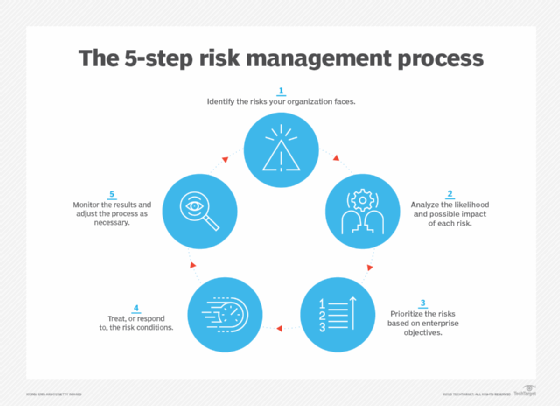The Growing Importance of Risk Management in Health and Safety
Wiki Article
The Important Value of Risk Management in Achieving Organizational Goals
In the rapidly evolving company landscape, the ability to browse unpredictability has actually become an imperative. This is where Risk Management actions in, giving an organized technique to determining, analyzing, and mitigating possible obstructions to progress. It's more than simply a protective procedure - it's a calculated device, fostering resilience and technology. As we check out the crucial duty of Risk Management in attaining organizational objectives, one can't ask yourself yet help: exactly how does this translate right into real-world success?Comprehending the Idea of Risk Management in Organization

The Important Duty of Risk Management in Strategic Preparation
Incorporating Risk Management into critical planning works as a secure for organizations, securing their long-term plans with a strong foundation of preparedness and durability. It runs as the company's radar, finding prospective threats and vulnerabilities that might interrupt the path in the direction of achieving their stated purposes. Risk Management offers a framework for anticipating unpredictabilities and developing ideal feedbacks, ensuring the company's survival and prosperity even despite hardship. By integrating Risk Management into calculated preparation, companies can change these uncertainties right into opportunities for development and technology. This calculated interweaving of Risk Management fosters versatility, making organizations much more durable and enabling them to navigate the ever-changing service landscape confidently. As a result, Risk Management becomes an important tool in critical preparation, crucial in securing sustainable success.
Methods for Identifying, Assessing, and Prioritizing Threats
Navigating the complicated landscape of dangers needs the application of particular strategies for their assessment, prioritization, and recognition. The process starts with Risk identification, employing tools such as SWOT evaluation, which helps in determining potential hazards and possibilities. Next, Risk assessment is conducted to ascertain the prospective effect and likelihood of each Risk. Tools such as Risk matrices and impact-probability graphes are made use of for this. Finally, this hyperlink threats are prioritized based upon their prospective impact and chance, allowing companies to concentrate their sources on critical risks. This methodical strategy makes certain a thorough understanding of the Risk landscape, making it possible for organizations to make enlightened decisions and successfully manage threats to accomplish their objectives - importance of risk management.Safeguarding Business Workflow Through Effective Risk Management
In business landscape laden with unpredictabilities, reliable Risk Management plays a pivotal function in securing business procedures. It acts as a safety shield, alleviating the unfavorable impacts of prospective dangers and making certain the smooth functioning of all procedures. By identifying and examining prospective hazards, Risk Management allows organizations to develop robust backup strategies. This preventative strategy help in keeping functional security, also when faced with unanticipated scenarios. Fundamentally, Risk Management is the lifeline that maintains the organizational operations afloat amidst stormy waters. It makes certain not only the survival but the lasting growth of a company, making it an indispensable device in achieving business goals. Hence, organizations need to purchase extensive Risk Management techniques to secure their operations.
Converting Possible Dangers to Opportunities: The Power of Risk Management
While possible dangers might initially look like obstacles to business success, reliable Risk Management can change them into opportunities. An aggressive approach to take the chance of Management includes identifying, assessing, and focusing on risks to develop methods that turn them into potential advantages. This procedure demands the growth of a risk-aware society within the company, urging individuals to view risks as prospective catalysts for adjustment and development, instead of simple threats. importance of risk management. Via this lens, possible hazards end up being chances to innovate, improve procedures, and strengthen durability. Hence, by leveraging the power of Risk Management, companies can not only YOURURL.com safeguard their operations however additionally stimulate growth and attain their goals in an uncertain organization atmosphere.Situation Studies: Success Stories of Risk Management Driving Service Objectives
Effective implementation of Risk Management techniques has actually yielded impressive lead to numerous services, highlighting the advantages of this approach. International firms like Microsoft and Google, for example, have actually leveraged Risk Management to decrease risks and make use of possibilities, driving their organization goals ahead. Microsoft's aggressive Risk Management method assisted it pivot swiftly during the 2020 pandemic, transitioning to remote job smoothly, thus maintaining efficiency. Google, by analyzing and mitigating potential dangers in its cloud-based services, has guaranteed continuous service, consequently strengthening customer depend on. These examples highlight how successful Risk Management can not only guide organizations free from possible mistakes however likewise assist them in the direction of their strategic purposes. Thus, Risk Management is important to the pursuit of organizational goals.
Final thought
Finally, Risk Management is fundamentally essential in achieving business goals. It offers a methodical approach to determining, assessing, and addressing prospective hazards and chances. More than simply mitigating threats, it additionally promotes innovation, durability, and lasting development. By incorporating Risk Management into critical planning, companies can better browse unpredictabilities, safeguard operations, and capitalise on possibilities, thus aligning with long-term goals.At its core, Risk Management is the process of determining, assessing, and addressing possible risks that could adversely influence an organization's goals or procedures. Next, Risk analysis is performed to establish the possible influence and chance of each Risk. Dangers are prioritized based on their possible influence and likelihood, allowing organizations to focus their resources on critical risks. By determining and analyzing possible risks, Risk Management allows companies to establish robust go to website backup strategies. An aggressive method to run the risk of Management involves recognizing, examining, and focusing on dangers to create techniques that transform them right into potential advantages.
Report this wiki page